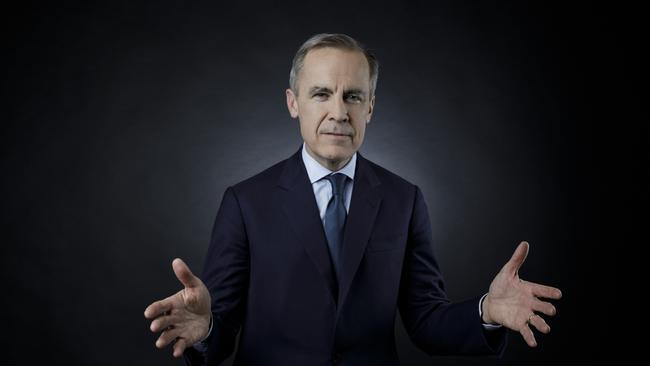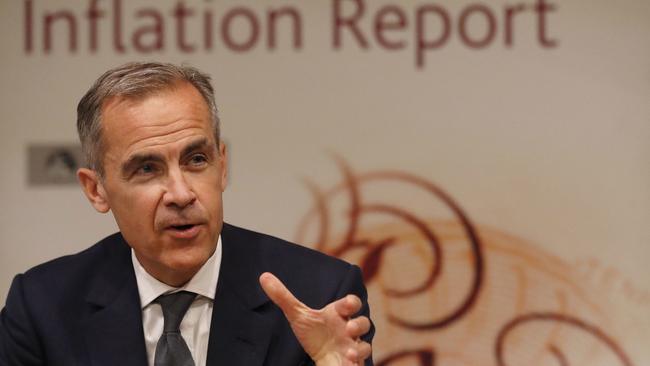Two-time central banker on a crusade to turn industry green … gradually

After seven years as governor of the Bank of England, Carney joined the Canadian global giant Brookfield Asset Management as vice-chairman and head of transition investing.
Last month, he and Brookfield’s head of renewable power Connor Teskey announced the $US7bn ($9.8bn) Brookfield Global Transition Fund, the largest fund to focus on the transition to a net-zero economy.
They spoke to The Weekend Australian, Carney from Ottawa and Teskey from London, where he also run’s Brookfield’s European operations.
Mark Carney has known Brookfield CEO Bruce Flatt for 25 years and says joining the firm was a meeting of minds. “At the time, Bruce, Connor and his partners were thinking about setting up a broader impact strategy. We began talking and pretty quickly came to the view that this was the biggest issue, addressing climate change.
“I’d like to say I put my money where my mouth is. I didn’t have much money, being in the public sector, so I’m putting my time where my mouth is, turning this risk into a commercial opportunity.
“And guess what? We are going where the emissions are, helping companies figure out how to get them down, and then we will be partnering with them in how to actually to do it.”
Carney’s timing is good. Many businesses are being pushed by ESG activists to sell off high-carbon assets, but leaders like Glencore’s Ivan Glasenberg and Magellan’s Hamish Douglass warn that sell-offs are just passing on the problem in a much bigger crisis.
Brookfield is well known in Australia but not for its green credentials. Over several decades Brookfield Renewables has amassed a $59bn portfolio with 21,000MW of generating capacity. Started as a pure play hydro fund, it now has wind and solar assets around the world. But Teskey says increasingly these investments are about solving the problems in energy transition: being both a capital provider and importantly an operating partner that can offer in-house expertise.
“It’s the single biggest differentiator,” said Teskey. “Many large businesses simply don’t know where to start. How am I going to decarbonise over the next 30 years?
“Brookfield has been a leading provider and producer of green energy. We start with that and then Mark and myself and our teams work with companies to say, let us start with green power procurement, but then what’s next? What can we do that is specific to your sector?
“EVs for auto companies, preparing for hydrogen for steel companies, building out more renewables for power companies. That first step comes really naturally to us and then we can leverage our footprint to what is next.”
Carney stresses the fund is about transition, with the aim of backing brown and turning it green by the end of fund life.
“This is a decarbonisation strategy and you’ve got to go to where the emissions are,” he says. “You’ve got to put capital to invest to reduce those emissions. That does take capital and sometimes it takes new technology.”
Because the fund is a pure play on energy transition and not a multi-impact fund, Brookfield is looking to take a lead in greenhouse gas accounting, reporting on the decarbonisation impact of the capital for each investment. At present Carney says the fund, which counts Singapore’s Temasek and the Ontario Teacher’s Pension Fund as founding investment partners, is focused on proven technologies, commercial technologies.

“We will be nimble over time with the fund. The advantage of being an operator as well is we can see some technologies that are not fully commercial yet but probably will be over the life of the fund in certain jurisdictions, and I have to say that Australia in that regard in many respects will lead the way in hydrogen.”
Teskey says carbon capture and storage is on the radar. “Fossil fuel industrials often do recognise the need to decarbonise, do have the want to decarbonise, but maybe don’t have the capital.
“If we can be the funding or operating partner that helps finance and build out CCS to capture their emissions and reduce their carbon character, that’s the type of investment we’d like to make.”
Big greenhouse gas emitters may seem obvious candidates, but Brookfield sees a commercial opportunity to put business on the path to net zero across the spectrum.
“It’s easy to look at a coal company and say we’re going to price that into their cost of capital but over the next 30 years; every business is going to need to decarbonise,” said Teskey. “Some are in the spotlight today, others will be more in the spotlight in the future. If world economies are going to reach the climate change goals, divestment and avoidance is not going to get us there.”
For investors, sources say target returns are in line with Brookfield’s flagship infrastrastructure and renewable power vehicles over the last 20 years. “We see no reason to compromise. There is no discount by investing in decarbonisation.”
Now also the UN Special Envoy for Climate Action and Finance, Carney continues to watch markets closely. Businesses are adopting their own net zero targets, and lenders pricing in carbon risk. So are carbon markets today running ahead of governments?
“Markets anticipate, markets lead and markets see the momentum that there is in terms of public opinion, which has shifted massively,” Carney says.
Government policy hasn’t gone all the way, but there is also momentum.
“When I was leaving the Bank of England we had 30 per cent of global emissions covered by country strategies; now it is three-quarters. We had 20 countries with net zero objectives, now it’s 131. We had $US5 trillion of assets in the global financial system that had a commitment to net zero. It’s $US80 trillion now. It’s bigger than global GDP.
“In the end, we need the market to find out the best way to reduce emissions, to allocate capital, to support those opportunities and quite candidly to make commercial returns along the way, so it’s not just about managing risk.
“This whole process is about flipping an existential risk into a massive commercial opportunity for the service of people.”
Asked about the Australian government’s refusal to commit to zero net emissions by 2050 just 10 weeks ahead of COP26, Carney says: “This is a high-ambition COP and the expectation is that every country, private sector aside, is going to significantly up ambition by Glasgow.
“Commitments are important. They help give a sense of where policy is going to go, what the time line, what the scale of ambition is. To be on track for 1.5 degrees, we need global emissions down by 50 per cent by the end of this decade, and that concentrates the mind.
“Australia has many, many strengths and contributions here, not least the incredible entrepreneurial capabilities, and we are see it in spades around this issue already. I’m also familiar that within Australia at the state level there are a number of commitments that are there.”
Government policy and regulation is moving markets and delivering more certainty.
Carney cites the UK ban on internal combustion engine sales from 2030. “What’s happened in the intervening 15 months? There has been investment in Tyneside, in auto plants and investment throughout the chain in electric vehicles production.”
This has led to work on charging infrastructure and electricity generation across Europe. “Those signals are important and they make real dollar impacts in terms of investments.”
So it would be a good thing if Morrison came to Glasgow in November with a commitment? “The Prime Minister will bring much to Glasgow so we look forward to his arrival,” Carney says with a grin.



Mark Carney is the only person to have ever run two central banks: in Canada, then England. After 15 months in the private sector he has a seat at the leaders’ top table as the world economy grinds towards net zero carbon emissions, with a sharp reckoning ahead at the COP26 meeting in Glasgow in October. And he looks forward to the arrival of Prime Minister Scott Morrison.